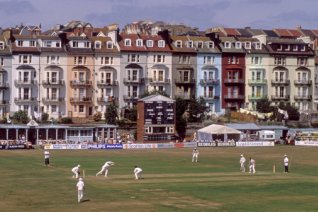By Charles Randall
11 April 2012

One of the more eye-catching books to be published in recent years has been Britain’s Lost Cricket Grounds (Aurum Press: £25), a wonderful peek by author Chris Arnot at a disappearing heritage.
So many evocative illustrations under one cover is rare enough, but the variety of lost venues ranges from first class to club to works facilities to country house to village. Some cricket grounds have been swallowed by shopping precincts (including the County ground at Hastings shown right left) or housing, while other grounds have simply become fallow when interest in cricket dwindled.
The lovely gabled pavilion among the trees at Bletchley Park still stands at a Buckinghamshire venue that made its own mark in history with the cracking of the Enigma code during The War. Bletchley Town CC moved away in the 1950s. Lakenham, where Norfolk used to attract big crowds for minor counties cricket, is another well known name that has disappeared after the Colman mustard family sold out to developers. Sheffield Park, in Sussex, is a fine rural ground that actually has not quite been lost, though well worth a mention for its provenance and association with Lord Sheffield, of Sheffield Shield fame.
The last first class match at the Central Ground, Sussex's venue in Hastings, took place in 1989, a few years before Hastings Priory CC moved to Horntye up on the cliffs. The low stands and backs of boarding houses with iron ballustrades overlooked what WG Grace called "the truest piece of turf in the United Kingdom". Gilbert Jessop once smashed 191 in an hour and a half in 1907 when sixes had to be struck out of the ground to count as six runs -- he hit five. These days a shopping precinct has extinguished such past glories, and more recently the County Ground at Southampton disappeared under housing when Hampshire moved out of town for their new stadium.
Arnot visits a total of 38 places, not an exhaustive list, and no doubt readers could add their own memories of forgotten grounds. The variety is interesting, and the venues include Hastings, Southampton, Bletchley Park, Lakenham, Sheffield Park, Tonbridge, Shillinglee, Cirencester, Stroud, the extraordinary Crabble at Dover, Dudley (condemned for safety reasons), Beeston, Rodney Parade in Newport, Imperial in Bristol, Stanford Hall, the former home of business mogul Sir Julien Cahn, Newstead, an old colliery ground in Nottinghamshire, and The Circle, now a car park for Hull City FC. The geography extends to the north and beyond, to Scotland.
The beauty of the book, published last October, is photography and anecdotes squeezed out of eye witnesses and archives. Anyone who enjoys gazing at cricket grounds and wondering what those players were thinking or what life was like in long-gone days would be entranced.
Book published by www.aurumpress.co.uk

